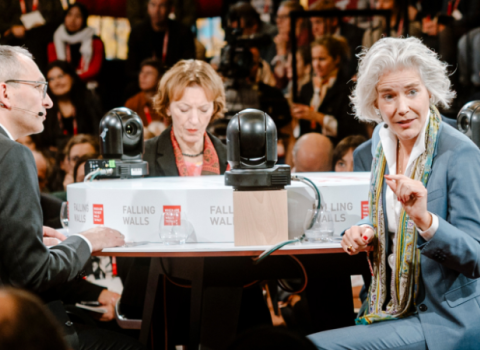The country is lagging behind the EU and China as a reliable research partner. But this can be fixed

Photo credits: Josh Johnson / Unsplash
As a former US State Department official responsible for international science partnerships, I’ve experienced my fair share of cross-border snarl-ups.
Perhaps the most frustrating was when a piece of equipment called Icarus, the world’s largest liquid-argon neutrino detector, had to be transferred from the European Organization for Nuclear Research (CERN) in Switzerland to the US’s Fermilab particle physics lab in Illinois.
Yet resolving whether CERN or Italy owned Icarus meant it sat, unused, in Fermilab’s car park in 2017 for around a year while lawyers quibbled over the details.
Organising complex joint science work across oceans is always hard. When it comes to being a reliable science partner, I’ve observed the US fall far behind other research powers like the EU and China.
Despite calls from think tanks and former and current government officials to form technology alliances capable of confronting global technology competition, recent US efforts have focused primarily on policies seeking to reduce the transfer of sensitive technology to adversarial nations rather than improving the ability of the US to meaningfully collaborate with international partners.
The US government tends to use punitive hammers, such as export controls and sanctions, and employs few constructive nails, such as partnership programmes, from which to build meaningful alliances. This narrow focus has already weakened US influence globally, convincing some of the country’s closest partners of the need to reduce their reliance on the US.
Inattention to the nuts and bolts of science and technology diplomacy has undermined the ability of the US to be a destination country for major physics projects. Leadership in the field now comes from Europe and Asia, where smaller countries with smaller budgets have no choice but to work together to build major projects.
Empowered by its single market and freedom of movement, the EU has embraced this role; it is now the host of many major facilities including CERN, the Extreme Light Infrastructure laser facility, the European Centre for Medium-Range Weather Forecasts, the International Thermonuclear Experimental Reactor (ITER) and many others.
In contrast, working with the US is seen as “difficult,” as a science advisor from a Five Eyes Anglosphere intelligence alliance country characterised it to me. Foreign partners often cite as challenges a lack of centralised processes, a legalistic approach to even simple collaborations, an inability to commit resources beyond a fiscal year or continuing resolution, the complexity of the US visa process and a resistance or inability to implement joint programmes.
Political gifts
Science and technology agreements are often treated as political gifts to foreign countries rather than as meaningful pragmatic instruments. “Unlike in most other cases, [science and technology agreements] with the USA do not bear a commitment of the signatories to spend money together. This is one of the reasons why they are not taken very seriously,” wrote German scientists Tim Flink and Ulrich Schreiterer in 2010.
The most common output from an international meeting is a press release, often called a joint statement. Valuable international statements must be accompanied by participants’ willingness and ability to use the statement to drive outcomes. For example, the Galway Statement on Atlantic Ocean Collaboration resulted in years of coordination activities among the US, Canada, the EU, and other Atlantic partner countries and led to the Okeanos Explorer mapping a substantial portion of the north Atlantic. Similarly, the Tokyo Statement on Quantum Cooperation helped motivate US and Japanese companies to elevate collaborative activities, overcoming administrative hurdles in both governments.
Related articles
- EU needs diaspora researchers and science attachés involved in diplomacy
- Europe reviews science diplomacy policy after Ukraine invasion shock
- US needs to do better in science diplomacy, White House says
For US negotiators, political and procedural hurdles create an atmosphere where ambitious ideas are frequently downgraded to more achievable, lower-effort projects. A request for a joint programme might become a one-off trip for foreign officials to several US science centres under the international visitor leadership programme, for example.
All this tactical effort ends up deflecting the long-run priorities of science diplomacy away from actually facilitating international science and technology cooperation. Worse, organising meetings in which the US cannot make commitments starkly contrasts with that of other countries and multilateral organisations such as China and the EU.
Improving US capacity
In 2022, I co-led a report by the National Science and Technology Council’s Subcommittee on International Science and Technology Coordination that provided Congress with 12 findings and 16 recommendations to improve the government’s international science and technology capacity.
Action since has been limited: a subsequent report, released in 2024, found that making progress on all the recommendations “will require additional time, congressional support, and sustained action from US departments and agencies.”
Yet these reports left out some of the most politically and administratively sensitive recommendations. For example, science agencies could be encouraged to seek blanket authority to negotiate international agreements from the State Department for complex multilateral science projects. This would make it easier for them to move legal documents into place quickly. Agencies could alternatively seek congressional authorisation to enter into agreements or collaborations, such as Congress’s authorisation of US participation in ITER through the Energy Policy Act of 2005, to codify the necessary flexibilities to facilitate major projects such as the Long Baseline Neutrino Facility or the Electron-Ion Collider.
And if Congress formally recognised international scientific organisations like CERN under the International Organizations Immunities Act, it would be easier for them to contribute to US domestic efforts and mirror the privileges granted to them by other countries.
It’s helpful to remember that the technological leadership position the US enjoyed during World War II and throughout the Cold War had as much to do with the country’s management of projects and supply chains as it did the skills of its scientists. Other countries took note and have moved to replicate this competitive advantage.
We cannot afford to see our capacity to build big things and take on impossible challenges diminish further. If the US is to remain the world’s scientific superpower, then we have no choice but to sweat the small stuff.
Cole Donovan is a former US State Department official. He is now associate director at the Federation of American Scientists. This viewpoint is a condensed version of an article that appeared originally in Issues in Science & Technology.





 A unique international forum for public research organisations and companies to connect their external engagement with strategic interests around their R&D system.
A unique international forum for public research organisations and companies to connect their external engagement with strategic interests around their R&D system.